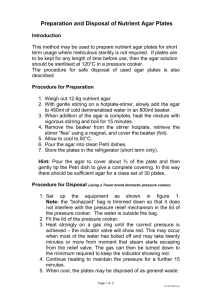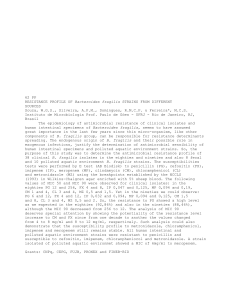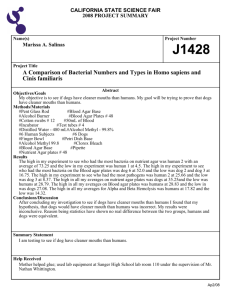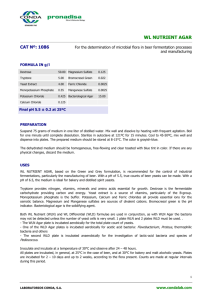BBL Bacteroides Bile Esculin Agar (BBE)
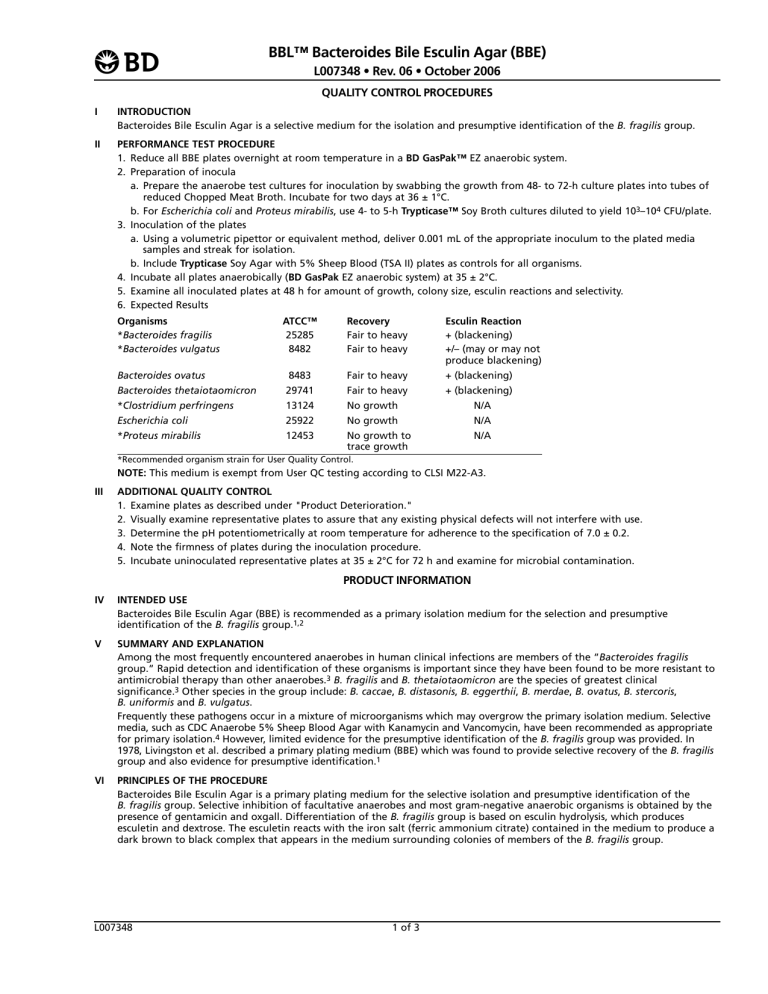
!
BBL™ Bacteroides Bile Esculin Agar (BBE)
L007348 • Rev. 06 • October 2006
I
QUALITY CONTROL PROCEDURES
INTRODUCTION
Bacteroides Bile Esculin Agar is a selective medium for the isolation and presumptive identification of the B. fragilis group.
II PERFORMANCE TEST PROCEDURE
1. Reduce all BBE plates overnight at room temperature in a BD GasPak™ EZ anaerobic system.
2. Preparation of inocula a. Prepare the anaerobe test cultures for inoculation by swabbing the growth from 48- to 72-h culture plates into tubes of reduced Chopped Meat Broth. Incubate for two days at 36 ± 1°C.
b. For Escherichia coli and Proteus mirabilis , use 4- to 5-h Trypticase™ Soy Broth cultures diluted to yield 10 3 –10 4 CFU/plate.
3. Inoculation of the plates a. Using a volumetric pipettor or equivalent method, deliver 0.001 mL of the appropriate inoculum to the plated media samples and streak for isolation.
b. Include Trypticase Soy Agar with 5% Sheep Blood (TSA II) plates as controls for all organisms.
4. Incubate all plates anaerobically ( BD GasPak EZ anaerobic system) at 35 ± 2°C.
5. Examine all inoculated plates at 48 h for amount of growth, colony size, esculin reactions and selectivity.
6. Expected Results
Organisms
*
*
Bacteroides fragilis
Bacteroides vulgatus
Bacteroides ovatus
Bacteroides thetaiotaomicron
* Clostridium perfringens
Escherichia coli
ATCC™ Recovery
25285
8482
8483
29741
13124
25922
Fair to heavy
Fair to heavy
Fair to heavy
Fair to heavy
No growth
No growth
+ (blackening)
+/– (may or may not produce blackening)
+ (blackening)
+ (blackening)
N/A
N/A
* Proteus mirabilis 12453 No growth to trace growth
N/A
*Recommended organism strain for User Quality Control.
NOTE: This medium is exempt from User QC testing according to CLSI M22-A3.
III ADDITIONAL QUALITY CONTROL
1. Examine plates as described under "Product Deterioration."
2. Visually examine representative plates to assure that any existing physical defects will not interfere with use.
3. Determine the pH potentiometrically at room temperature for adherence to the specification of 7.0 ± 0.2.
4. Note the firmness of plates during the inoculation procedure.
5. Incubate uninoculated representative plates at 35 ± 2°C for 72 h and examine for microbial contamination.
PRODUCT INFORMATION
IV INTENDED USE
Bacteroides Bile Esculin Agar (BBE) is recommended as a primary isolation medium for the selection and presumptive identification of the B. fragilis group.
1,2
V SUMMARY AND EXPLANATION
Among the most frequently encountered anaerobes in human clinical infections are members of the “ Bacteroides fragilis group.” Rapid detection and identification of these organisms is important since they have been found to be more resistant to antimicrobial therapy than other anaerobes.
3 B. fragilis and B. thetaiotaomicron are the species of greatest clinical significance.
3 Other species in the group include: B. caccae , B. distasonis , B. eggerthii , B. merdae , B. ovatus , B. stercoris ,
B. uniformis and B. vulgatus .
Frequently these pathogens occur in a mixture of microorganisms which may overgrow the primary isolation medium. Selective media, such as CDC Anaerobe 5% Sheep Blood Agar with Kanamycin and Vancomycin, have been recommended as appropriate for primary isolation.
4 However, limited evidence for the presumptive identification of the B. fragilis group was provided. In
1978, Livingston et al. described a primary plating medium (BBE) which was found to provide selective recovery of the B. fragilis group and also evidence for presumptive identification.
1
VI PRINCIPLES OF THE PROCEDURE
Bacteroides Bile Esculin Agar is a primary plating medium for the selective isolation and presumptive identification of the
B. fragilis group. Selective inhibition of facultative anaerobes and most gram-negative anaerobic organisms is obtained by the presence of gentamicin and oxgall. Differentiation of the B. fragilis group is based on esculin hydrolysis, which produces esculetin and dextrose. The esculetin reacts with the iron salt (ferric ammonium citrate) contained in the medium to produce a dark brown to black complex that appears in the medium surrounding colonies of members of the B. fragilis group.
L007348 1 of 3
VII REAGENTS
Bacteroides Bile Esculin Agar
Approximate Formula* Per Liter Purified Water
Pancreatic Digest of Casein ......................................14.5 g
Papaic Digest of Soybean Meal.................................. 5.0 g
Sodium Chloride.......................................................... 5.0 g
Esculin .......................................................................... 1.0 g
Ferric Ammonium Citrate .......................................... 0.5 g
Oxgall ..........................................................................15.0 g
*Adjusted and/or supplemented as required to meet performance criteria.
Hemin .................................................................................... 0.01 g
Gentamicin ............................................................................ 0.1 g
Vitamin K
1
............................................................................ 0.01 g
Agar ......................................................................................14.0 g
Growth Factors .................................................................... 1.8 g
Warnings and Precautions: For in vitro Diagnostic Use.
If excessive moisture is observed, invert the bottom over an off-set lid and allow to air dry in order to prevent formation of a seal between the top and bottom of the plate during incubation.
Pathogenic microorganisms, including hepatitis viruses and Human Immunodeficiency Virus, may be present in clinical specimens. "Standard Precautions" 5-8 and institutional guidelines should be followed in handling all items contaminated with blood and other body fluids. After use, prepared plates, specimen containers and other contaminated materials must be sterilized by autoclaving before discarding.
Storage Instructions: On receipt, store plates in the dark at 2–8°C. Avoid freezing and overheating. Do not open until ready to use. Minimize exposure to light. Prepared plates stored in their original sleeve wrapping at 2–8°C until just prior to use may be inoculated up to the expiration date and incubated for recommended incubation times. Allow the medium to warm to room temperature before inoculation.
Product Deterioration: Do not use plates if they show evidence of microbial contamination, discoloration, drying, cracking or other signs of deterioration.
VIII SPECIMEN COLLECTION AND HANDLING
Specimens suitable for culture may be handled using various techniques. For detailed information, consult appropriate texts.
9,10
Specimens should be obtained before antimicrobial therapy has been administered. Provision must be made for prompt delivery to the laboratory.
IX PROCEDURE
Material Provided: Bacteroides Bile Esculin Agar
Materials Required But Not Provided: Ancillary culture media, reagents, quality control organisms and laboratory equipment as required.
Test Procedure: Observe aseptic techniques.
The agar surface should be smooth and moist, but without excessive moisture. Media should be reduced immediately prior to inoculation by placing under anaerobic conditions for 6–24 h.
11 An efficient and easy way to obtain suitable anaerobic conditions is through the use of BD GasPak EZ anaerobic systems.
Streak the specimen as soon as possible after it is received in the laboratory. As some strains of the B. fragilis group may not grow well due to the selective properties of the medium, it is advisable to include a nonselective blood agar medium such as
CDC Anaerobe 5% Sheep Blood Agar.
Incubate immediately under anaerobic conditions or place in a holding jar flushed with oxygen free gas(es) until sufficient plates are accumulated (but no longer than 3 h).
12 Incubation should be at 35 ± 2°C for at least 48 h. Regardless of anaerobic system used, it is important to include an indicator of anaerobiosis such as the GasPak disposable anaerobic indicator.
User Quality Control: See "Quality Control Procedures."
Quality control requirements must be performed in accordance with applicable local, state and/or federal regulations or accreditation requirements and your laboratory's standard Quality Control procedures. It is recommended that the user refer to pertinent CLSI (formerly NCCLS) guidance and CLIA regulations for appropriate Quality Control practices.
X RESULTS
After 48 h of incubation, colonies of the B. fragilis group should be greater than 1 mm in diameter and appear gray, circular, entire and raised. A Gram stain should be performed to assist in the identification. Most anaerobes other than the B. fragilis group are inhibited. Esculin hydrolysis is indicated by a blackening of the medium around the colonies.
NOTE: If plates are to be examined after 24 h, examine quickly and reincubate under anaerobic conditions.
In order to determine the relationship to oxygen of each colony type present on anaerobic solid media, inoculate the following media: 13
1. One anaerobe blood agar plate to be incubated anaerobically.
2. One aerobic blood agar (or chocolate agar) plate to be incubated in an atmosphere of carbon dioxide. The chocolate agar is particularly needed to distinguish nutritionally-fastidious Haemophilus species and other bacteria which will grow on anaerobe blood agar incubated anaerobically and on chocolate agar under increased carbon dioxide tension but which fail to grow on blood agar in the presence of carbon dioxide or in air.
3. One aerobic blood agar plate to be incubated aerobically.
4. Tubes of Enriched Thioglycollate Medium and/or Cooked Meat Medium and a tube of Peptone Yeast Extract Glucose Broth.
Incubate all cultures at 35 ± 2°C for a minimum of 24 h and up to 7 days.
Record the relationship to oxygen as either obligate anaerobe or nonanaerobe (aerotolerant anaerobe, microaerophilic, or facultative anaerobe).
13
Organisms failing to grow on the aerobic subculture plates may be presumed to be obligately anaerobic in terms of their oxygen requirements.
Colonies of the type(s) which prove to be obligate anaerobes can be further studied using the corresponding broth cultures.
14,15
L007348 2 of 3
XI LIMITATIONS OF THE PROCEDURE
B. vulgatus may not hydrolyze esculin.
2,3
For identification, organisms must be in pure culture. Morphological, biochemical, and/or serological tests should be performed for final identification. Consult appropriate texts for detailed information and recommended procedures.
9,10,16-19
A single medium is rarely adequate for detecting all organisms of potential significance in a specimen. It should be recognized that organisms generally susceptible to the antimicrobial agent in a selective medium may be completely or only partially inhibited depending upon the concentration of the agent, the characteristics of the microbial strain and the number of organisms in the inoculum. Organisms that are generally resistant to the antimicrobial agent should not be inhibited. Cultures of specimens grown on selective media should, therefore, be compared with specimens cultured on nonselective media to obtain additional information and help ensure recovery of potential pathogens.
XII AVAILABILITY
Cat. No.
221836
Description
BBL ™ Bacteroides Bile Esculin Agar (BBE), Pkg. of 10 plates
XIII REFERENCES
1. Livingston, S.J., S.D. Kominos, and R.B. Yee. 1978. New medium for selection and presumptive identification of the Bacteroides fragilis group.
J. Clin. Microbiol. 7 :448-453.
2. Mangels, J.I. 2004. Culture media for anaerobes, p.4.3.1-p.4.3.5 In H.D. Isenberg (ed.), Clinical microbiology procedures handbook, vol. 2.
American Society for Microbiology, Washington, D.C.
3. Jousimies-Somer, H.R., and S.M. Finegold. 1991. Anaerobic gram-negative bacilli and cocci, p. 538-553. In A. Balows, W.J. Hausler, Jr., K.L.
Herrmann, H.D. Isenberg, and H.J. Shadomy (ed.), Manual of clinical microbiology, 5th ed. American Society for Microbiology, Washington,
D.C.
4. Dowell, V.R., Jr., G.L. Lombard, F.S. Thompson, and A.Y. Armfield. 1977. Media for isolation, characterization, and identification of obligately anaerobic bacteria. CDC laboratory manual. Center for Disease Control, Atlanta.
5. National Committee for Clinical Laboratory Standards. 2001. Approved Guideline M29-A2. Protection of laboratory workers from occupationally acquired infections, 2nd ed. NCCLS, Wayne, PA.
6. Garner, J.S. 1996. Hospital Infection Control Practices Advisory Committee, U.S. Department of Health and Human Services, Centers for
Disease Control and Prevention. Guideline for isolation precautions in hospitals. Infect. Control Hospital Epidemiol. 17 :53-80.
7. U.S. Department of Health and Human Services. 1999. Biosafety in microbiological and biomedical laboratories, HHS Publication (CDC), 4th ed. U.S. Government Printing Office, Washington, D.C.
8. Directive 2000/54/EC of the European Parliament and of the Council of 18 September 2000 on the protection of workers from risks related to exposure to biological agents at work (seventh individual directive within the meaning of Article 16(1) of Directive 89/391/EEC). Official
Journal L262, 17/10/2000, p. 0021-0045.
9. Murray, P.R., E.J. Baron, J.H. Jorgensen, M.A. Pfaller, and R.H. Yolken (ed.). 2003. Manual of clinical microbiology, 8th ed. American Society for
Microbiology, Washington, D.C.
10. Forbes, B.A., D.F. Sahm, and A.S. Weissfeld. 2002. Bailey and Scott's diagnostic microbiology, 11th ed. Mosby, Inc., St. Louis.
11 Dowell, V.R., Jr., and T.M. Hawkins. 1987. Laboratory methods in anaerobic bacteriology. CDC laboratory manual. HHS Publication No. (CDC)
87-8272. Centers for Disease Control, Atlanta.
12. Martin, W.J. 1971. Practical method for isolation of anaerobic bacteria in the clinical laboratory. Appl. Microbiol. 22 :1168-1171.
13. Allen, S.D., J.A. Siders, and L.M. Marler. 1985. Isolation and examination of anaerobic bacteria, p. 413-433. In E.H. Lennette, A. Balows, W.J.
Hausler, Jr., and H.J. Shadomy (ed.), Manual of clinical microbiology, 4th ed. American Society for Microbiology, Washington, D.C.
14. Rodloff, A.C., P.C. Appelbaum, and R.J. Zabransky. 1991. Cumitech 5A, Practical anaerobic bacteriology. Coordinating ed., A.C. Rodloff.
American Society for Microbiology, Washington, D.C.
15. Jousimies-Somer, H.R., P.H. Summanen, H. Wexler, S.M. Finegold, S.E. Gharbia, and H.N. Shah. 2003. Bacteroides, Porphyromonas , Prevotella ,
Fusobacterium , and other anaerobic gram-negative bacteria, p. 880-901. In P.R. Murray, E.J. Baron, J.H. Jorgensen, M.A. Pfaller, and R.H.
Yolken (ed.), Manual of clinical microbiology, 8th ed. American Society for Microbiology, Washington, D.C
.
16 Holt, J.G., N.R. Krieg, P.H.A. Sneath, J.T. Staley, and S.T. Williams (ed.). 1994. Bergey's Manual™ of determinative bacteriology, 9th ed. Williams
& Wilkins, Baltimore.
17. MacFaddin, J.F. 2000. Biochemical tests for identification of medical bacteria, 3rd ed. Lippincott Williasms & Wilkins, Baltimore.
18. Koneman, E.W., S.D. Allen, W.M. Janda, P.C. Schreckenberger, and W.C. Winn, Jr. 1997. Color atlas and textbook of diagnostic microbiology,
5th ed. Lippincott-Raven, Philadelphia.
19. Isenberg, H.D. (ed.). 2004. Clinical microbiology procedures handbook, vol. 1, 2 and 3, 2nd ed. American Society for Microbiology,
Washington, D.C.
Becton, Dickinson and Company
7 Loveton Circle
Sparks, Maryland 21152 USA
800-638-8663
ATCC is a trademark of the American Type Culture Collection.
BD, BD Logo, BBL, GasPak and Trypticase are trademarks of Becton, Dickinson and Company. ©2006 BD.
L007348 3 of 3



